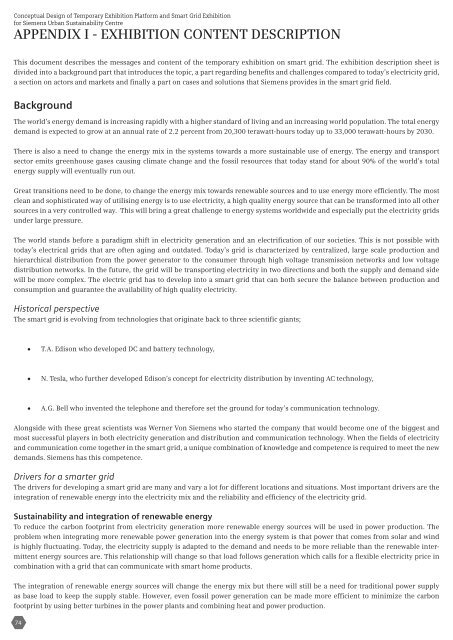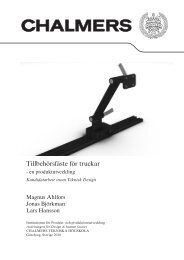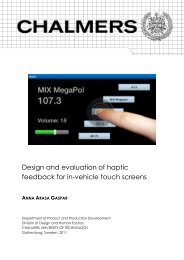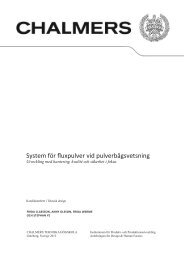Thesis - Teknisk Design
Thesis - Teknisk Design
Thesis - Teknisk Design
- No tags were found...
Create successful ePaper yourself
Turn your PDF publications into a flip-book with our unique Google optimized e-Paper software.
Conceptual <strong>Design</strong> of Temporary Exhibition Platform and Smart Grid Exhibitionfor Siemens Urban Sustainability CentreAppendix I - Exhibition Content DescriptionThis document describes the messages and content of the temporary exhibition on smart grid. The exhibition description sheet isdivided into a background part that introduces the topic, a part regarding benefits and challenges compared to today’s electricity grid,a section on actors and markets and finally a part on cases and solutions that Siemens provides in the smart grid field.BackgroundThe world’s energy demand is increasing rapidly with a higher standard of living and an increasing world population. The total energydemand is expected to grow at an annual rate of 2.2 percent from 20,300 terawatt-hours today up to 33,000 terawatt-hours by 2030.There is also a need to change the energy mix in the systems towards a more sustainable use of energy. The energy and transportsector emits greenhouse gases causing climate change and the fossil resources that today stand for about 90% of the world’s totalenergy supply will eventually run out.Great transitions need to be done, to change the energy mix towards renewable sources and to use energy more efficiently. The mostclean and sophisticated way of utilising energy is to use electricity, a high quality energy source that can be transformed into all othersources in a very controlled way. This will bring a great challenge to energy systems worldwide and especially put the electricity gridsunder large pressure.The world stands before a paradigm shift in electricity generation and an electrification of our societies. This is not possible withtoday’s electrical grids that are often aging and outdated. Today’s grid is characterized by centralized, large scale production andhierarchical distribution from the power generator to the consumer through high voltage transmission networks and low voltagedistribution networks. In the future, the grid will be transporting electricity in two directions and both the supply and demand sidewill be more complex. The electric grid has to develop into a smart grid that can both secure the balance between production andconsumption and guarantee the availability of high quality electricity.Historical perspectiveThe smart grid is evolving from technologies that originate back to three scientific giants;• T.A. Edison who developed DC and battery technology,• N. Tesla, who further developed Edison’s concept for electricity distribution by inventing AC technology,• A.G. Bell who invented the telephone and therefore set the ground for today’s communication technology.Alongside with these great scientists was Werner Von Siemens who started the company that would become one of the biggest andmost successful players in both electricity generation and distribution and communication technology. When the fields of electricityand communication come together in the smart grid, a unique combination of knowledge and competence is required to meet the newdemands. Siemens has this competence.Drivers for a smarter gridThe drivers for developing a smart grid are many and vary a lot for different locations and situations. Most important drivers are theintegration of renewable energy into the electricity mix and the reliability and efficiency of the electricity grid.Sustainability and integration of renewable energyTo reduce the carbon footprint from electricity generation more renewable energy sources will be used in power production. Theproblem when integrating more renewable power generation into the energy system is that power that comes from solar and windis highly fluctuating. Today, the electricity supply is adapted to the demand and needs to be more reliable than the renewable intermittentenergy sources are. This relationship will change so that load follows generation which calls for a flexible electricity price incombination with a grid that can communicate with smart home products.The integration of renewable energy sources will change the energy mix but there will still be a need for traditional power supplyas base load to keep the supply stable. However, even fossil power generation can be made more efficient to minimize the carbonfootprint by using better turbines in the power plants and combining heat and power production.74
















